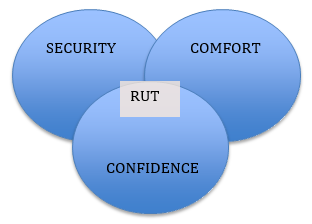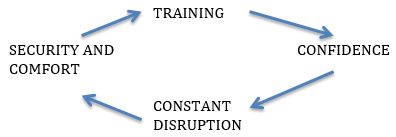When the rut brings COMFORT
A process improvement mindset is something that seems appealing to most people, right? Why would you want to do something the same way, over and over again, when you actually know a better way to get something accomplished, which, by the way, could save you time and be more productive? Surprisingly enough, I have encountered colleagues, clients and friends who have actually defended the stance that doing the same process in the same exact way for years brings them comfort, security and confidence.
And in the midst of these three things, lies the RUT.

How, you may ask, is this possible?
They find comfort in the familiarity of the process. In knowing that they do not need to change, consider improvements or take risks. Their adrenaline is in check.
They find security in their jobs and their hours. They do not want their tasks to take less time and have fewer hours accounted for in their day, thus making them eventually redundant (or so they believe).
They find confidence in doing their jobs perfectly, of knowing their tasks like the back of their hand. They do not want any changes, because as soon as any change is made, this change needs to be learned and perfected, thus making them insecure.
How is it possible that these arguments are valid? Why are people so resistant to change and to improvement? Why do they not see the value of always improving? The value of having free time to pursue matters that you previously couldn’t since you were busy with your usual tasks and work?
I never fully understood the reason change management exists in the lean environment until I came across these colleagues, clients and friends. Though the goal of change management is to guide you successfully through the changes your individual and collective work will experience, it is not effective unless the person fully recognizes the importance of the change needed.
This is a critical step and one that is often missed because we forget about the comfort, security and confidence that some people enjoy in their old way of doing things. We have to be able to sensitively address each of these feelings and assure the person that this change will be for their best interest. We need to be able to address how the new processes will also give them comfort, security and confidence.
Comfort in knowing that the company / institution still values you as an employee and wants you to continue being an integral part of the workforce. The company is spending time and money to train you; they are investing in your future.
Security in knowing that since you are being trained in this new process you will become an important asset to the company / institution. Your job is guaranteed. You are not becoming redundant, but an integral part of the future of your company / institution.
Confidence in knowing the new processes in your job and, after completing the training and having some practice, being able to master them. Also, at a later time, being able to articulate why the new way is better than the old way will in itself be a confidence booster.
Being able to address all these feelings in the change management process should help our colleagues, clients and friends to successfully transition to the new way of doing things. However, there is still an additional problem. Do you think that having gone through the process improvement and overall change management process once would be enough to give you a work environment mentality of continuous improvement and thus, be open to future change? I do not believe this is the case.
Going through this process once or twice may not be enough, because again the RUT BRINGS COMFORT. Employees will soon become comfortable, secure and confident with the new way of doing things, which could be improved, but they do not want to go through that change process again. Therefore, they will complacently sit in their desks and continue their same work routine without stepping out of their comfort zone to actively pursue process improvement opportunities.
So how do we get them out of the rut successfully? How do we help them become positive agents of change? I believe there are many ways to do this, but two practices have resonated with me throughout the years. Their success rate is above and beyond that of other methods used and thus, they have become two foundational pillars in my lean management practices:
1. Focus on Training: Continually training all employees on how to identify positive change and how this change can make you more successful. I would even venture into comparing this training to a brain washing (in the most positive sense!), giving all employees a new mindset that by repetition and examples. This then becomes everyone’s standard operating procedure – the “new norm”.
2. Constant disruption. Continually make improvements to the work processes so that all workers become accustomed to making changes and being involved in these. Have an “improvement ideas box” and implement all feasible suggestions made by the employees to encourage them in their continuous improvement-learning journey. Ensure that all improvements are publicly announced and the employees can witness the before and after, understand the improvements and how their work environment is better because of these changes.

These two actionable practices will help the employees gain comfort, security and confidence in their abilities to make changes.
Gain comfort by continually receiving training in how to identify and implement changes to the point that it will eventually impact the work culture and bring comfort to employees by knowing that this is what is expected of them, they understand it and can partake in it.
Security in knowing that if you are on board with the changes and the continuous improvement mentality, you will become an integral part of the company / institution. You will be a positive change agent.
Gain confidence in knowing that you can execute these and any future changes. You are now fully qualified to continually to bring positive changes to the company/ institution.
Via these two practices, the company or institution will also now be able to successfully implement change management and reinforce a continuous improvement mentality.
The RUT NO LONGER BRINGS YOU COMFORT, but CHANGE does!
